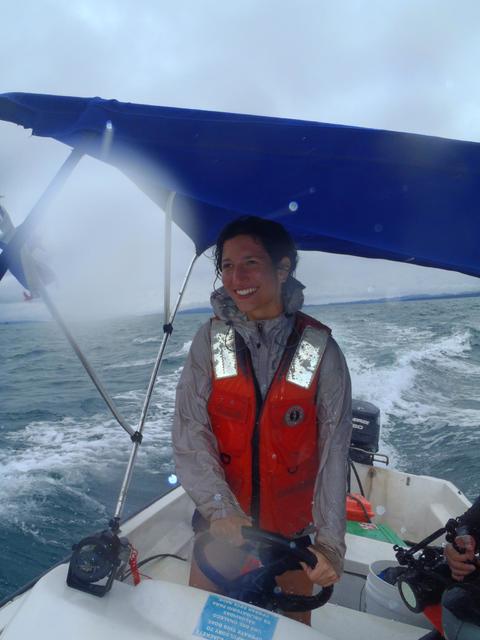For more than a century a tiny silver pelagic fish, the herring, has played a critical role in the lives of people living in the San Juans.
“Interviewing elderly fishers I found out that herring were a staple food for families living in the San Juans Islands during the early 20th century,” University of Washington researcher Eleni Petrou says. “It supported large industrial fisheries in the Salish Sea. What we see today may only be a small portion of the abundance and diversity that existed 100 years ago.”
This is the riddle Petrou hopes to answer through her project, which she discussed March 8, at the Orcas Island Emmanuel Episcopal Church during a talk co-sponsored by the SeaDoc Society, YMCA Camp Orkila, and the San Juan County Marine Resource Committee. At her talk, she discussed some of the lesser known facts about herrings, like how they can communicate by passing gas. But her focus is studying the ancient DNA of herring bones found in archealogical sites from several thousand years ago. From the DNA she hopes to provide insight regarding herring populations pre-urbanization and post-urbanization, as well as shed light on the history of the herring and human bond.
Importance of fish
It is the human connection, which make herring different than other forage fish, Tina Whitman, science director at Friends of the San Juans, said, “People have depended on them for over 10,000 years.”
Whitman said she gets more reports about herring than any other forage fish. Locally, in the San Juans, documented spawning locations are Eastsound and Westsound on Orcas, Blind Bay on Shaw, and Mud Bay, Hunter Bay, and Shoal Bay on Lopez, according to Whitman, who has been studying forage fish in the San Juans for 15 years. Spawning season begins roughly late March, and it is possible to see evidence because the water turns white.
“There used to be a large population that spawned in Westcott Bay, but that stock is now classified as disappeared.” She said, explaining there has not been any documented herring spawning there since 2004. While the disappearance may be linked to a drop in eelgrass, Whitman says researchers don’t currently have any conclusive reasons for it.
Herring populations regionally have been decreasing as well. According to Petrou, there are two types of Pacific herring, spring spawners and fall spawners. The only place in the US where the spring spawners spawn is an isolated group at Cherry Point, and their numbers are growing smaller.
“A lot of research is going on,” Whitman said. “But no smoking gun has been found yet. It use to be one of the largest populations in Washington state.” Research has been ramped up over the years, she added, but it’s difficult to document, and there is a lot of missing information.
Petrou also emphasized the need for more information, “Given how little we know about the underlying processes affecting Cherry Point fish, we need to investigate whether they are begin intercepted by fisheries outside Washington state, and continue researching what effects pollution might have on herring larval development and survival.”
While she does not believe herring are in danger of going extinct, she stressed the importance of maintaining their diversity and abundance, “We have to make sure their populations remain at a level that can sustain other species that depend on them.”
Communication
Petrou said, all fish communicate, “Depending on the species and situation, fish can use sound, motion, color, chemical signals, and electric impulses to sense their environment and communicate with each other.”
In “Pacific and Atlantic Herring Produce Burst Pulse Sounds,” Ben Wilson Robert S. Batty and Lawrence M. Dill wrote about their studies of captive and wild herring. In a nut shell, they concluded that herring appear to communicate by farting.
They are not, according to Petrou, the only fish that does so. She described an occasion when she was helping a scientist deploy underwater recording devices to study fish noises on tropical reefs in Panama. She described how noisy animals of the tropical reefs are, often grunting clicking and crackling, especially around dawn and dusk, much like birds.
“I once had a giant Goliath grouper try to scare me off of its territory by making tremendous booming sounds with its swim bladder,” Petrou said. “It was so loud I felt the vibration in my chest – an awesome experience!”
Petrou is hopeful that her project will be completed in about two more years, but it is a big endeavor and not with out issues. Her team collects the herring while spawning to ensure samples are taken from a single population. During the first year they realize the tissue samples collected were covered in herring sperm, which contaminated the genetic analysis. She spent a lot of time figuring out how to destroy the sperm DNA while preserving her sample DNA.
The work is worth it she believes, “They have really awesome schooling behaviors, they are an important food source for a multitude of species,” she said, “including human, sea birds, Chinook salmon, sea lions, seals and humpback whales. So much important information about their ecology is still unknown to us, including what influences their abundance.”




